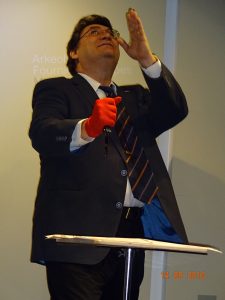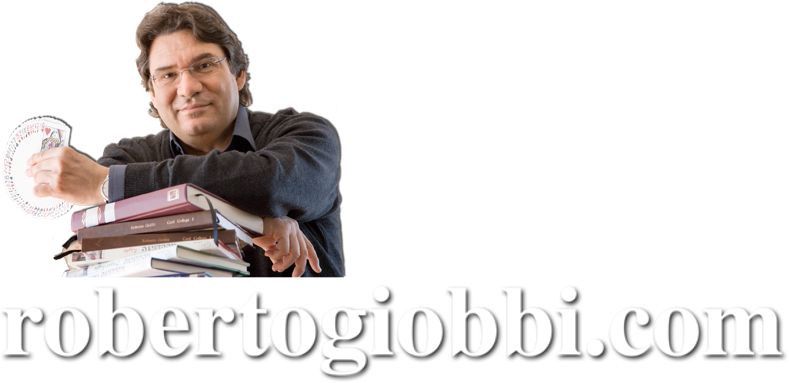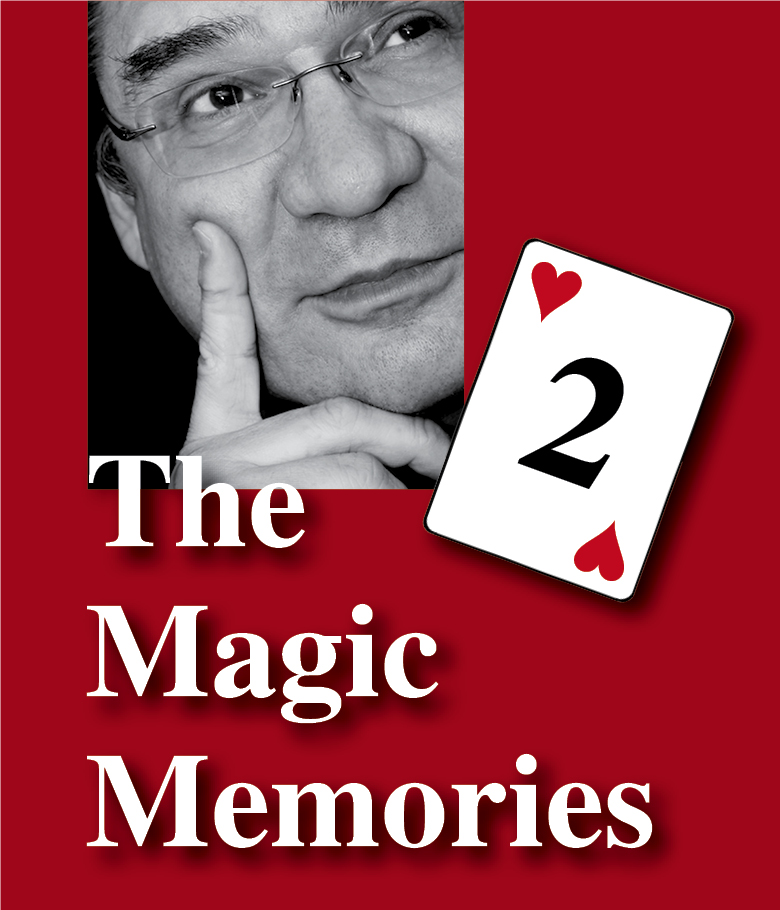
Hi everyone!
Here are The Magic Memories #44, gone online SUN, 31st October 2021, at 0:07h.

Comments on the “Magialdia Show”
This week’s magical roundabout is my answer to a question asked by reader Pedro Bryce, a young man from the new school of card magic in Spain and an accomplished practitioner of the art . He sent in an email asking, “What were the “pieces” (routines) that you chose for your three shows in Magialdia?”
Brief flashback: In my The Magic Memories #41 of OCT 10th, I gave a report of the Spanish magic convention Magialdia, and mentioned that I performed six shows of ca. 25 minutes each at the Fournier Playing Card Museum, over a period of two days and before an audience of ca. 30 persons. Following is an attempt at discussing not only the program I did, as this has only limited significance, but the considerations that influenced my decisions.
If you have studied my book Stand-up Card Magic you will remember that I devote the entire first chapter to examine the criteria that influence a performance in a stand-up situation, the “premise”, if you will. Far more than in a close-up situation, in a parlor type of show the setting and the conditions can make or break the act and are as important as the tricks and the presentation. Due to Corona restrictions, everyone in the audience had to wear a mask, and a distance of about one meter (ca. one yard) was set between a chair and another. Fortunately, I was still allowed to hand things out to the audience, and even bring up audience members (talk about the logic of some restrictions…). Nonetheless, this was far from a typical situation I was used to in over thirty (!) years of professional experience performing in six languages around the world.
First, I knew I’d had only half as many spectators as would normally fit in that room; second, my contact with the audience was restricted (I don’t see their faces, just the eyes); third, the over-all atmosphere in general, and among the members of the audience in particular, was severely altered. Add to this that although I’m fluent in Spanish, it is not my native language, and I don’t live in Spain, a factor that for instance greatly affects humorous remarks, gags, lines etc. Also, in this type of shows, which are sponsored by the city in the context of this great magic festival and which are therefore free, you get a very heterogenous audience: adults and children (although the organizers mention in the program that the shows are not children’s dhows, there are always a few of them), men and women from different walks of life, yuppies and retired people, well, you get the idea. This is different than if I get booked at a scientific convention where I know that everyone is for instance a medical doctor, and all speak English etc. Finally, the performing area, although set in the culturally-charged context of a historical building as a museum, these premises are not made for visual performances, so extra care has to be taken to be seen and heard.
These and other considerations taken, I decided on a three-part program I have already commented upon in the above-mentioned post: I stuck to the age-old formula of three routines: A visual beginning (a rope routine with audience interaction), another visual but intriguing middle (Vernon’s “Symphony of the Rings”), and a rather conceptual finale with a strong finish (my “Stickler”, the card stabbing routine from my book Stand-up Card Magic). Following a few extra comments on each piece:
Rope routine: I’ve been doin this routine for over 30 years now, and for me it is the ideal opener for various reasons. First, each of the dozen effects that takes place in a time-frame of six to eight minutes is visual and happens on a vertical plane, so I can use it for a small birthday party with a dozen people in a private living room, but also in a large theater – I have in fact performed this routine for audiences as large as eight hundred people, and with proper background and lighting everyone could see the effects. Second, each effect is of a universal symbolism, e.g., regardless of the spectator’s ethnical, cultural or demoscopic background, the effects will be understood. I’m sometimes asked if I don’t get bored performing the same routine over such a long period. I wondered myself for a while, but then was fortunate to hit on a quote by Heraclitus, a pre-socratic philosopher, who said, “You never step into the same river twice.” I must say that this caused a major paradigm shift in me, as I realized that I never perform the same trick twice (I’ll leave this for you to ponder).
The rope routine I do is essentially the one Shigeo Tagaki personally taught me when I visited Japan on an incredible tour organized by Max Maven and his manager David Belenzon ca. 1989, but this is another story 🙂 It is really a finely crafted assemblage of ideas by George Sands, Jean Merlin and Shigeo Tagaki, along with bits and pieces that are lost in the annals of conjuring, as we like to say when we don’t know who to credit… but obviously I’ve deleted and added dozens of details over the years. Anyway, one of the good things of this routine is that the first six effects are very visual: two short pieces of about ten inches each grow to about three times their size, and then again the double of that, only to eventually fuse into one long rope about 3 meters in length (ca. 3 yards). Then the ends are removed, the rope cut, and the ends jump across à la George Sands. This has become quite “classic” in the past two decades, but it doesn’t take away anything from their efficiency. Not only are the effects superb and easily understood (see above), above all they allow men to monitor the audience’s reaction, and in particular that of individual spectators, whom I can then identify as potential assistants to bring up in the next sequences.
This I do, and it is preferably a lady, as the interaction I get is, if I may say so myself, charming and intriguing. Well, the routine continues with some known and some less-known effects, some of which have fooled well-posted colleagues 🙂 The finale is also untypical and really great: Two pieces of cut rope get restored, but one of them by the spectator herself, so she gets part of the final applause, as I applaud myself (!) and take her back to her seat. This has been as good an opener as I’ve ever come across.
Linking Rings: The second, middle, routine I chose for the given circumstances was “The Linking Rings”. Granted, it is an “oldie”, but given the conditions it proved to be a good choice. Furthermore, being situated in a museum that is a place treasuring a part of civilization’s heritage, it was easy to connect to the Linking Rings, also a piece from the magician’s classic repertoire. I would advise anyone who performs magic, whether occasionally or regularly, to learn an interactive, spoken routine of ca. 5 minutes. “Linking Rings” is one of the very few tricks that you can perform under virtually all conditions and in front of practically any type of audience, as everyone will understand the effects. Also, it is one among the half dozen tricks where the audience can come in at any moment of the routine, and still understand what’s going on and appreciate the climax. With most other tricks, especially card and mental tricks, if you miss the beginning you will be hard pressed to understand the rest, let alone the finale. This is why the Linking Rings are ideal openers if you perform in a Shopping Mall, on the street, at a Trade Show or other similar venue. It is perfect when nothing else goes, when you arrive at the place of the event, and it turns out conditions are not as agreed, when the audience doesn’t speak your language, when there are a lot of children etc.. Linking Rings you can always perform, surrounded and even walking around between tables. It is virtually a trouble-shooter for all situations. My routine takes Dai Vernon’s as a template, interwoven with a few sequences Richard Ross taught me when we met at the CeBit fair in Hannover, Germany, in 1988, but this is again another story 🙂 The routine could also be done to music, but I’m partial to text, so did my usual presentation, which jumps from language to language, but here I used mostly Spanish. In these rare cases I do script the trick, something which I do not always do.
Card Stab: So, after two rather visual routines, ropes and Linking Rings, I found the audience was ready for a more conceptional piece, a card trick. My card stabbing routine lasts ten to twelve minutes, and if you are interested you’ll find all details in “Stickler” in Stand-up Card Magic (The first Penguin Live Lecture also has the performance and detailed explanation of the trick). Although a lot less visual, this trick has something that is even more important than that, it appeals greatly to the emotions and allows the spectators to create images in their minds that are larger than any monitor could project. In this piece, as in all others of this type, it is very important to keep up a good pacing, without haste bit without unnecessary pauses (although there are several “dramatic” pauses – see “Pauses” in Sharing Secrets). In my opinion and professional experience I have found such pieces to be more memorable than purely visual effects. The latter are fascinating at the moment they occur, but the others last longer over time. This has a lot to do with how our perception and memory works… now you do the thinking.
Finally, I noticed that about 25% of the lines and comedic situations did not play as they usually do, maybe because I had not performed live for almost 12 months (never happened before!), but also because of the particular Corona conditions and cultural setting. With less performance experience such a situation can have fatal consequences, but with decades of shows in my backpack, I knew that it was neither me nor the tricks, but simply the conditions. This resulted in me not losing my self-confidence nor pacing as I simply pretended I got the reactions I usually get, with the same pauses and body language, and it did work. I recommend you remember this concept and use it.
Additional Comment
Before we part until next week, I would like to remind you that thinking about acts performed by any experienced performer can yield a profit in many senses. If yo search around a bit, you’ll discover some interesting publications. For a start try Programs of Famous Magicians by Max Holden, or Ian Keable’s 30 Years of Programmes from Daniels to Derren.
So, thank you, Pedro, for an interesting question – as you can see I’m never at loss for an answer, even a lengthy one for lack of time…
Hope the meanderings above have triggered some kind of thought and/or action with you, so you can say that now you know more than before, that you are a better magician than before and an altogether better person, olé! That would be neat – should call these the “Sunday Sermons” (or sermonette)… maybe 🙂
Have an excellent week!
Roberto Giobbi
PS: If you would like to see Pedro perform one of his pieces CLICK HERE.

